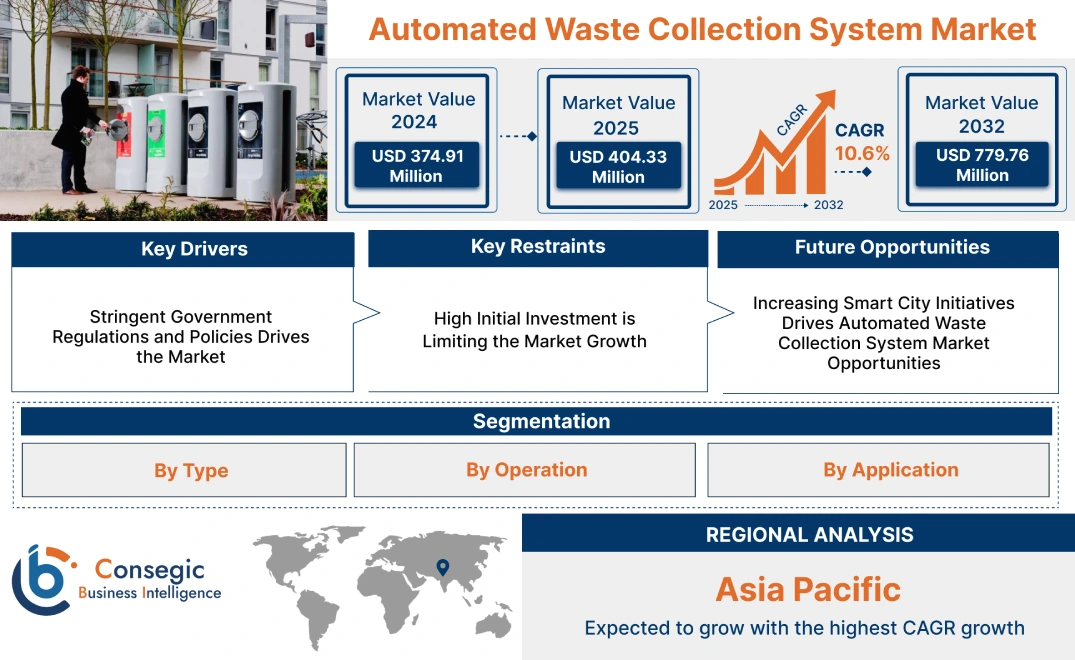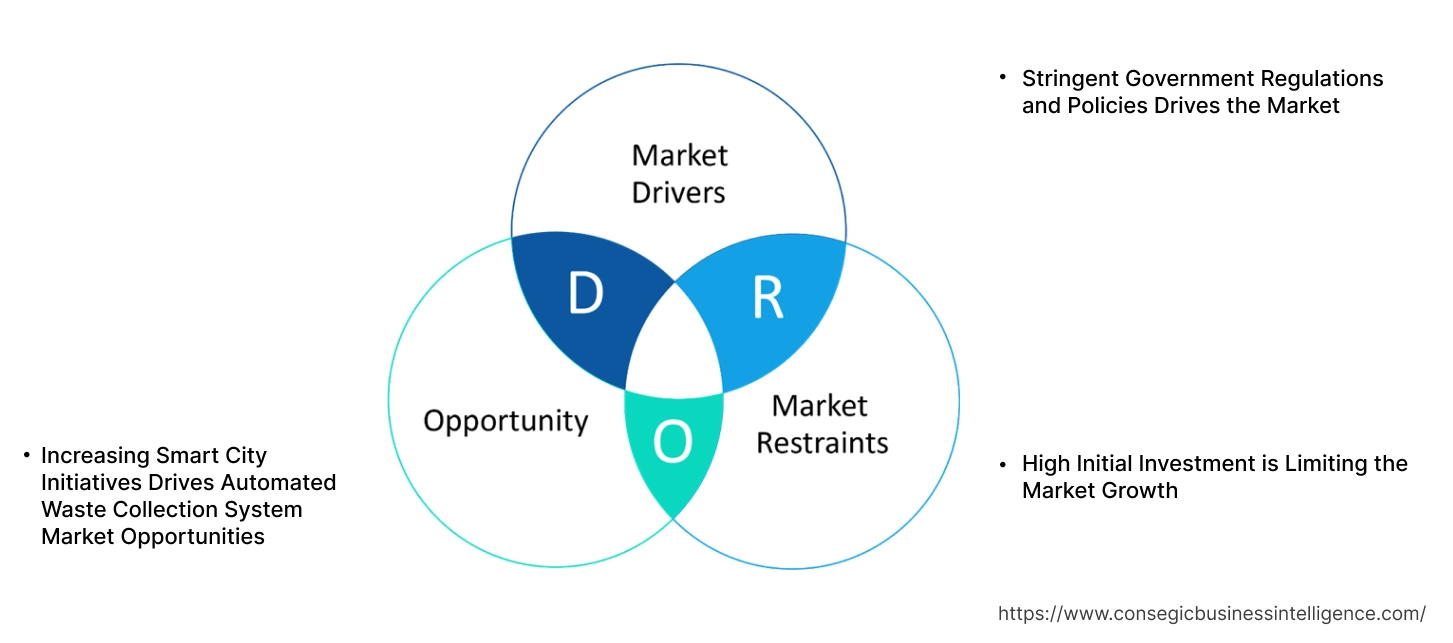Automated Waste Collection System Market Size:
Automated Waste Collection System Market is estimated to reach over USD 779.76 Million by 2032 from a value of USD 374.91 Million in 2024 and is projected to grow by USD 404.33 Million in 2025, growing at a CAGR of 10.6% from 2025 to 2032.
Automated Waste Collection System Market Scope & Overview:
Automated waste collection systems are advanced technologies that streamline waste management by using automated processes instead of traditional manual collection methods. The systems often involve underground pneumatic tubes or automated vehicles to collect, transport, and sometimes sort waste, leading to increased efficiency. Further, the system is used in a wide range of sectors including airports, healthcare, industries, sports facilities, hotels and restaurants, municipalities, and others. Furthermore, key trends driving the market include increasing adoption of smart city initiatives, growing focus on sustainability, stringent government regulations and a growing environmental consciousness.
Automated Waste Collection System Market Dynamics - (DRO) :
Key Drivers:
Stringent Government Regulations and Policies Drives the Market
Stringent government regulations and policies are significantly propelling the automated waste collection system market. The environmental mandates focus on reducing landfill waste, carbon emissions, and promoting efficient waste management necessitate the adoption of advanced solutions for effective handling of waste. Further, the increasing regulations drive municipalities and industries to invest in automated systems for improved hygiene, reduced operational costs, and enhanced sustainability, which in turn drives the market growth.
- For instance, in August 2022, Government of India implemented the Battery Waste Management Rules, 2022, making producers responsible for the collection and recycling of all battery types, including those used in EVs, portable devices, vehicles, and industrial applications. This is expected to drive the demand for waste collection systems for efficient handling of waste.
Thus, increasing governmental regulation and initiatives driven by growing awareness contribute significantly to the automated waste collection system market size.
Key Restraints:
High Initial Investment is Limiting the Market Growth
The high initial investment required for automated waste collection system significantly limits market growth, particularly in emerging economies with budget constraints or existing infrastructure. The costs associated with installing underground pipelines, vacuum systems, specialized collection stations, and providing standardized bins to residents can be substantial, often deterring municipalities and organizations from adopting these advanced solutions. Further, retrofitting waste collection systems into established urban areas presents additional financial burdens and logistical complexities compared to incorporating them into new developments. Thus, automated waste collection systems offer long-term benefits like reduced operational costs and improved efficiency. However, the considerable upfront capital expenditure remains a key barrier to widespread adoption and market growth.
Future Opportunities :
Increasing Smart City Initiatives Drives Automated Waste Collection System Market Opportunities
The increasing number of smart city initiatives globally offer significant opportunities in the automated waste collection system market. As cities strive for enhanced sustainability, efficiency, and improved quality of life, the system aligns perfectly with the core principles of smart urban development. Integrating automated waste management solutions into smart city frameworks allows for optimized resource management, reduced carbon footprints, and cleaner urban environments, contributing to the overall smart city vision. Furthermore, smart city initiatives involve the deployment of advanced sensor technologies, IoT infrastructure, and data analytics platforms, which can be seamlessly integrated with waste management system to enable real-time monitoring, predictive maintenance, and optimized collection schedules.
- For instance, as part of Saudi vision 2030, the country is actively developing several smart cities to diversify its economy and enhance citizens' quality of life. NEOM is a smart city project aiming for sustainable development through advanced technologies. Riyadh is transforming into a smart city using ICT to improve government services.
Thus, growing environmental concerns are leading to development of smart cities, which in turn drives the automated waste collection system market opportunities.
Automated Waste Collection System Market Segmental Analysis :
By Type:
Based on the type, the market is segmented into full vacuum system and gravity vacuum system.
Trends in the Type:
- A key trend in gravity vacuum systems is the advancement of automated discharge valves and control systems, which is driving the automated waste collection system market trends.
- Gravity vacuum systems are being combined with smart waste bins equipped with fill-level sensors, which in turn drive the automated waste collection system market size.
Full vacuum system accounted for the largest revenue share in the year 2024 and is anticipated to register the fastest CAGR during the forecast period.
- Increasing incorporation of advanced sensors to monitor waste levels, airflow, and system performance in real-time is driving the automated waste collection system market share.
- Further, there is an increasing emphasis on energy efficiency to reduce the overall environmental footprint and operational expenses of the systems.
- Furthermore, full vacuum systems are being designed to handle multiple waste streams more effectively which in turn drive the automated waste collection system market trends.
- For instance, Wärtsilä offers Vacuum Collection System that utilizes air pressure to transport sewage with minimal flush water, offering benefits like smaller and lighter piping, design flexibility, lower costs, motion insensitivity, water savings, and improved hygiene and odor control.
- Thus, as per automated waste collection system market analysis, integration of smart sensors, focus on energy efficiency, and enhanced waste stream management are driving the market.
By Operation:
Based on the operation, the market is segmented into stationary and mobile.
Trends in the Operation:
- Growing integration of mobile system with cloud-based management platforms drives the automated waste collection system market demand.
- Growing emphasis on sustainability in mobile systems is leading to the development and adoption of electric and hybrid collection vehicles.
Stationary accounted for the largest revenue share in the year 2024.
- Stationary systems are increasingly incorporating sophisticated software and algorithms to manage and optimize the entire pipeline network which in turn drives automated waste collection system market growth.
- Further, modern stationary systems are being designed with integrated waste sorting facilities at the central collection station in turn driving the automated waste collection system industry.
- For instance, Logiwaste AB offers stationary automated vacuum waste collection system that uses a network of pipes and inlets to transport waste via vacuum to a central terminal, where the air is separated, and the waste is stored in containers for removal and processing.
- Thus, as per automated waste collection system market analysis, aforementioned factors are driving the market.
Mobile is anticipated to register the fastest CAGR during the forecast period.
- Increasing advancements in vehicle automation and the integration of robotic arms for more efficient and safer waste collection.
- Further, mobile systems are equipped with GPS tracking, fill-level sensors on connected bins, and communication systems that provide real-time data on collection progress and bin status, which subsequently propels the automated waste collection system market expansion.
- Therefore, based on analysis, enhanced vehicle automation and real time data collection are anticipated to boost the growth of the market during the forecast period.
By Application:
Based on the application, the market is segmented into airports, healthcare, industries, sports facilities, hotels and restaurants, municipalities, and others.
Trends in the Application:
- Airports are increasingly adopting waste management systems to maintain high levels of cleanliness and improve the overall passenger experience by eliminating visible waste bins and reducing odors, which in turn drives the automated waste collection system market expansion.
- Stringent hygiene regulation and elimination of manual handling propels the automated waste collection system market.
Industries accounted for the largest revenue share of 43.98% in the year 2024.
- The growing demand for autonomous system for efficiently handling and transporting large volumes and reducing reliance on traditional and often cumbersome waste management methods.
- Further, increasing adoption to manage various industrial waste streams, including general waste, packaging materials, and specific manufacturing byproducts.
- Furthermore, waste management systems are increasingly being integrated with broader industrial automation systems, allowing for seamless and data-driven waste management which in turn drives automated waste collection system market growth.
- For instance, Envac offers advanced waste removal system which boosts the industrial productivity by efficiently capturing and transporting waste, preventing press stoppages and jams, maintaining registration, supporting higher speeds, ensuring clean cuts, and ultimately streamlining operations for manufacturers.
- Thus, based on analysis, autonomous vehicles, efficiently handling and technological advancements are driving the market.
Municipalities is anticipated to register the fastest CAGR during the forecast period.
- Growing incorporation of automated systems with smart city infrastructure, which in turn drives the automated waste collection system market share.
- Further, growing demand for sensors and data analytics in waste management to monitor waste generation patterns, optimize collection schedules, and improve overall efficiency, which in turn drives the automated waste collection system market demand.
- Therefore, based on analysis, aforementioned trends are anticipated to boost the market during the forecast period.
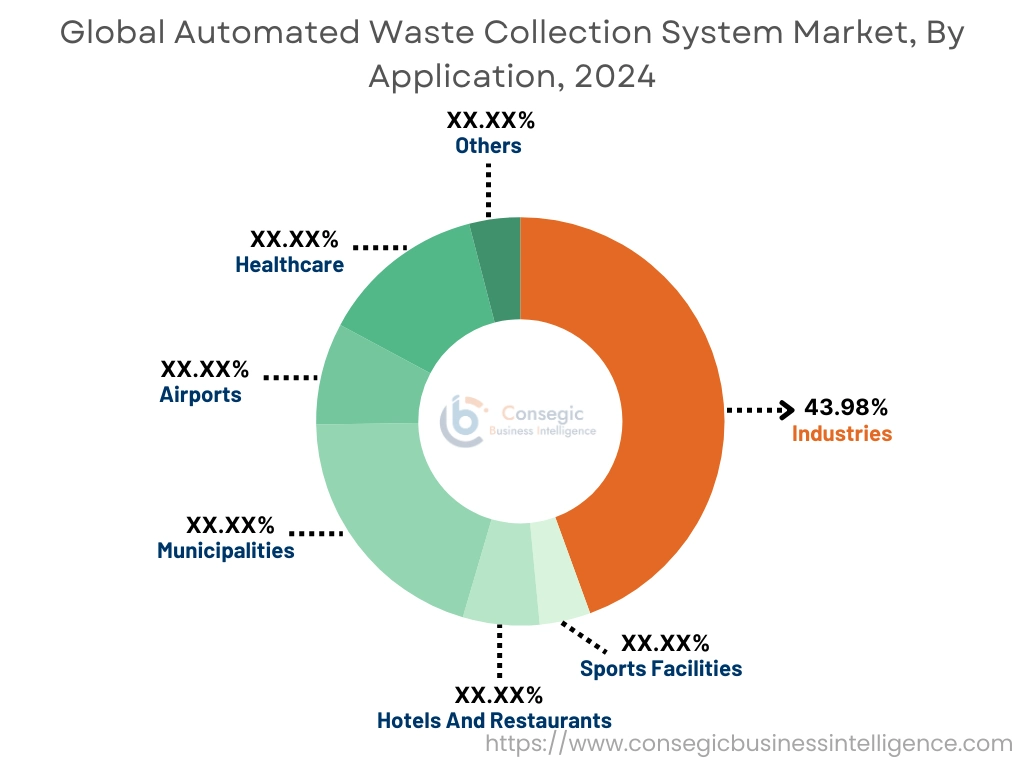
Regional Analysis:
The regions covered are North America, Europe, Asia Pacific, Middle East and Africa, and Latin America.
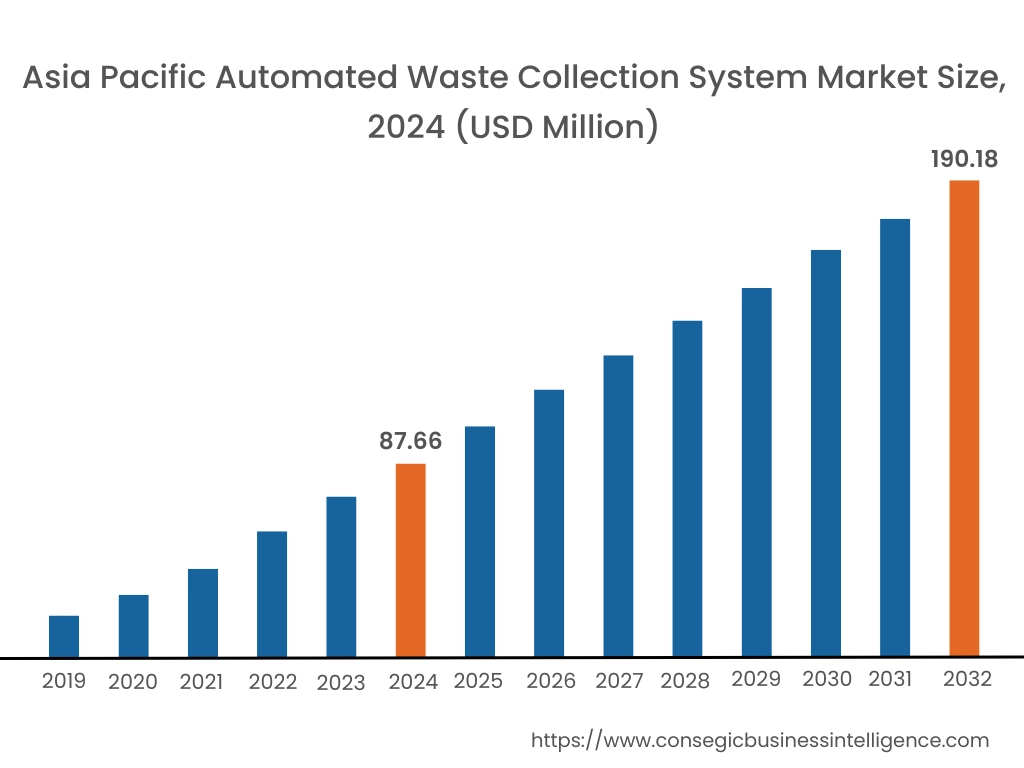
Asia Pacific region was valued at USD 87.66 Million in 2024. Moreover, it is projected to grow by USD 94.88 Million in 2025 and reach over USD 190.18 Million by 2032. Out of this, China accounted for the maximum revenue share of 36.83%. The market growth for automated waste collection system is mainly driven by rapid urbanization and industry growth. Additionally, the rising adoption of smart city initiatives is further driving the market.
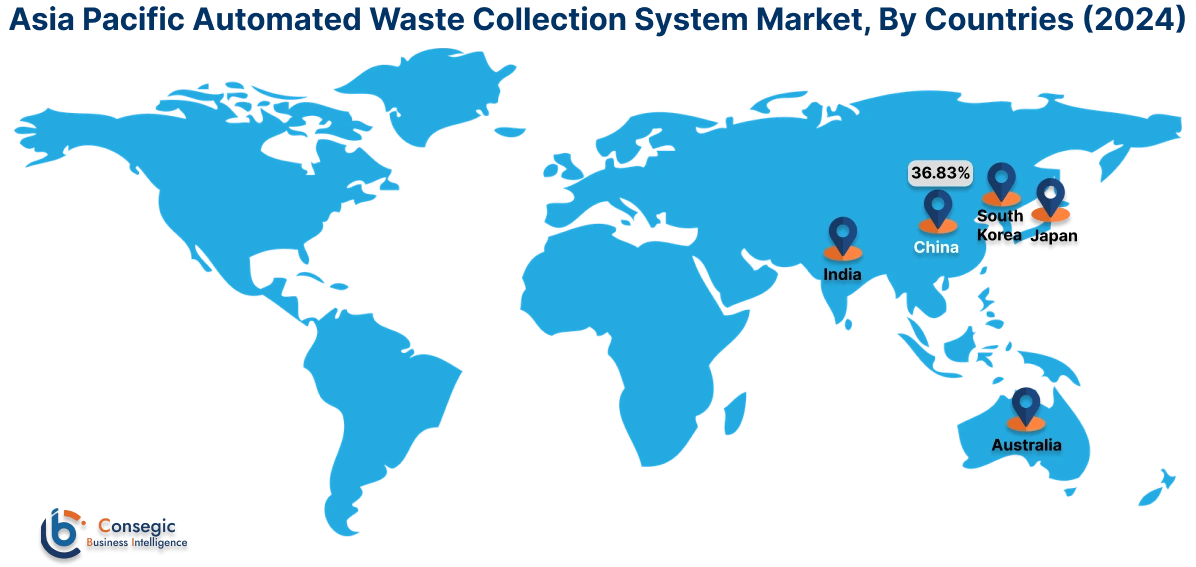
North America is estimated to reach over USD 204.76 Million by 2032 from a value of USD 98.61 Million in 2024 and is projected to grow by USD 106.33 Million in 2025. The North American market is primarily driven by increasing emphasis on efficient waste management, technological advancements, and stringent environmental regulations.
- For instance, in November 2024, US Environmental Protection Agency released “National Strategy to Prevent Plastic Pollution” focused on reducing production pollution, promoting innovative design, decreasing waste, and improving treatment, is a key driver for the waste management due to increasing environmental regulations.
- Additionally, in January 2023, Envac North America, a division of the Envac, formally launched its North American operations with the US and Canada as priority markets. Leveraging global experience, Envac North America aims to provide smart, automated waste collection solutions for hospitals, residential communities, and cities, contributing to improved waste and sustainability standards.
The regional trends analysis depicts stringent regulations promoting high recycling targets and a growing environmental awareness in Europe is driving the market. Additionally, the factors driving the market in the Middle East and African region are growing focus on modernizing infrastructure & waste management practices and government initiatives to improve public health and urban cleanliness. Further, increasing urbanization and waste generation in cities, coupled with a growing awareness of environmental issues and public health concerns is paving the way for the progress of market trends in Latin America region.
Top Key Players and Market Share Insights:
The global automated waste collection system market is highly competitive with major players providing solutions to the national and international markets. Key players are adopting several strategies in research and development (R&D), product innovation, and end-user launches to hold a strong position in the automated waste collection system industry. Key players in the global automated waste collection system market include-
- ENVAC GROUP (Sweden)
- LOGIWASTE AB (Sweden)
- AMCS GROUP (Ireland)
- Bondtech Corp (US)
- Ecosir Group (Finland)
- CAVERION CORPORATION (Finland)
- MARIMATIC OY (Finland)
- GREENWAVE SOLUTIONS (India)
- STREAM ENVIRONMENT (Malaysia)
- AWC BERHAD (Malaysia)
Recent Industry Developments :
Collaboration:
- In April 2025, Envac and SAVE Group S.p.A. launched a new pneumatic waste collection system at Venice's Marco Polo Airport, making it the second airport in Europe to adopt this technology. The system featuring over 500 meters of underground pipes and multiple inlets, allows for the separate collection and transport of waste to a collection station for later removal.
Automated Waste Collection System Market Report Insights :
| Report Attributes | Report Details |
| Study Timeline | 2019-2032 |
| Market Size in 2032 | USD 779.76 Million |
| CAGR (2025-2032) | 10.6% |
| By Type |
|
| By Operation |
|
| By Application |
|
| By Region |
|
| Key Players |
|
| North America | U.S. Canada Mexico |
| Europe | U.K. Germany France Spain Italy Russia Benelux Rest of Europe |
| APAC | China South Korea Japan India Australia ASEAN Rest of Asia-Pacific |
| Middle East and Africa | GCC Turkey South Africa Rest of MEA |
| LATAM | Brazil Argentina Chile Rest of LATAM |
| Report Coverage |
|
Key Questions Answered in the Report
How big is the Automated Waste Collection System market? +
The Automated Waste Collection System market is estimated to reach over USD 779.76 Million by 2032 from a value of USD 374.91 Million in 2024 and is projected to grow by USD 404.33 Million in 2025, growing at a CAGR of 10.6% from 2025 to 2032.
What specific segmentation details are covered in the automated waste collection system report? +
The automated waste collection system report includes specific segmentation details for type, operation, application, and regions.
Which is the fastest segment anticipated to impact the market growth? +
In the automated waste collection system market, municipalities is the fastest-growing segment during the forecast period.
Who are the major players in the automated waste collection system market? +
The key participants in the automated waste collection system market are ENVAC GROUP (Sweden), LOGIWASTE AB (Sweden), CAVERION CORPORATION (Finland), MARIMATIC OY (Finland), GREENWAVE SOLUTIONS (India), STREAM ENVIRONMENT (Malaysia), AWC BERHAD (Malaysia), AMCS GROUP (Ireland), Bondtech Corp (US), Ecosir Group (Finland), and others.
What are the key trends in the automated waste collection system market? +
The automated waste collection system market is being shaped by several key trends including increasing urbanization and population density, growing environmental concerns, stringent regulations, advancements in technology and smart city initiatives.
